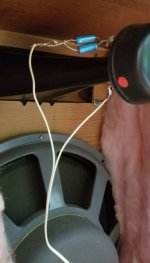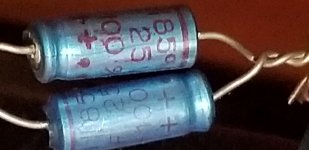I was asked by a friend if I knew why on a horn speaker he has (part of an older 2 speaker build with a full range 15" J.B. Lansing D13030-17000 Hz and an Oxford 4” X 10” exponential horn 900-20K Hz), does the horn have a pair of 85uF polarized caps in parallel, but soldered together with the negative of one cap with the positive of other at one side (end) of the pair with the other end of the pair the same (+ -) and then on to the speaker. The JBL is being used full range with no crossover and the horn has just the 2 caps in parallel.
He was given a second set of the same speakers and wanted to build another unit but is questioning the capacitor (crossover ?) configuration and I don't know the answer why the 1st build (50 years ago ?), used the cap configuration as shown. Any ideas?


He was given a second set of the same speakers and wanted to build another unit but is questioning the capacitor (crossover ?) configuration and I don't know the answer why the 1st build (50 years ago ?), used the cap configuration as shown. Any ideas?


It looks like they want to use a pair of polarised electrolytic caps to make a non-polarised cap suitable for crossover use.
If they've done it right, that should result in a first-order crossover.
However, IIRC a polarised cap driven backwards looks like a short circuit, so two of them wired like that won't actually be doing anything.
The caps should be wired in series, + to + or - to -.
Chris
If they've done it right, that should result in a first-order crossover.
However, IIRC a polarised cap driven backwards looks like a short circuit, so two of them wired like that won't actually be doing anything.
The caps should be wired in series, + to + or - to -.
Chris
Someone got it wrong, the capacitors must be in anti-series (negative terminals connected together).
Of course the way they are connected affects the net value, series connection is not the same value as parallel.
But anti-parallel (a reverse parallel connection) as shown is useless for a crossover, and will cause distortion.
Of course the way they are connected affects the net value, series connection is not the same value as parallel.
But anti-parallel (a reverse parallel connection) as shown is useless for a crossover, and will cause distortion.
Last edited:
The mismatched value is almost irrelevant compared to caps shorting with applied audio above a few (very few) Volts.
Is the horn still alive?
I would expect a very fried voice coil unless it was used with, say, a pocket transistor radio or a 2W record player.
Consider it as a 200uF capacitor , 20X larger than needed, in parallel with 4 or 5V Zeners and think whether it´s "protecting" horn from anything you feed that cabinet.
Is the horn still alive?
I would expect a very fried voice coil unless it was used with, say, a pocket transistor radio or a 2W record player.
Consider it as a 200uF capacitor , 20X larger than needed, in parallel with 4 or 5V Zeners and think whether it´s "protecting" horn from anything you feed that cabinet.
He'll have a pleasant surprise with the much better sound that will come out of the speaker,
when those capacitors are replaced with a nonpolar cap that works properly.
Your friend was sharp to have noticed this, instead of just duplicating the present mess.
when those capacitors are replaced with a nonpolar cap that works properly.
Your friend was sharp to have noticed this, instead of just duplicating the present mess.
Last edited: